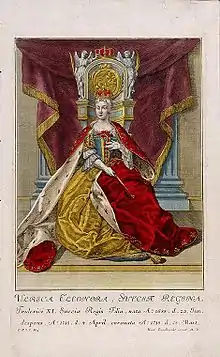
The 1719 Instrument of Government (Swedish: regeringsform) adopted on 21 February 1719 by the Riksdag of the Estates (Swedish parliament), was the constitution of the Kingdom of Sweden from 1719 to 1720. Although only in force for a few months, it has great significance in Swedish history, as its promulgation marked the end of the country's first period of absolutism (1680-1719) and the beginning of the period of constitutional monarchy and parliamentary government traditionally known as the Age of Liberty.
The Instrument came about as a result of the succession crisis which occurred after Charles XII of Sweden died childless during the Great Northern War, leaving two potential heirs: his sister Ulrika Eleonora the Younger, and his nephew Charles Frederick, Duke of Holstein-Gottorp.[1] The crisis was eventually resolved by a deal whereby the Riksdag acknowledged Ulrika as queen regnant, and in exchange she signed a new constitution, thereby renouncing the absolute monarchy instituted by her father King Charles XI.[2] As such it was in effect a revival of the Instrument of Government (1634), and indeed the title "Instrument of Government" (Swedish: regeringsform) was deliberately chosen to invoke that earlier document;[3] there are however substantial differences between the two, with the 1634 Instrument having a more narrowly descriptive and administrative function while the 1719 Instrument was explicitly intended to be a political constitution in the modern sense.[4]
Only a year after its promulgation, the 1719 Instrument of Government was replaced by a new constitution, the Instrument of Government (1720), although the two were largely identical in content.[5] The 1720 Instrument subsequently remained in force for the rest of the Age of Liberty, until absolutism was restored by King Gustav III's self-coup in 1772.
References
- ↑ Lundh-Eriksson, Nanna (1976). Den glömda drottningen: Karl XII:s syster Ulrika Eleonora d.y. och henes tid [The Forgotten Queen: The Sister of Charles XII. The Age of Ulrika Eleonora the Younger] (in Swedish). [Stockholm]: [Förf.] ISBN 91-970128-1-5. SELIBR 7790483.
- ↑ Lundh-Eriksson, Nanna (1976). Den glömda drottningen: Karl XII:s syster Ulrika Eleonora d.y. och henes tid [The Forgotten Queen: The Sister of Charles XII. The Age of Ulrika Eleonora the Younger] (in Swedish). [Stockholm]: [Förf.] ISBN 91-970128-1-5. SELIBR 7790483.
- ↑ Regeringsformen, Nordisk Familjebok (1915), p.1208 (in Swedish)
- ↑ http://sv.wikisource.org/wiki/Regeringsform_1634 Regeringsform 1634
- ↑ Regeringsformen, Nordisk Familjebok (1915), p.1208 (in Swedish)
Sources
- Lundh-Eriksson, Nanna (1976). Den glömda drottningen: Karl XII:s syster Ulrika Eleonora d.y. och henes tid [The Forgotten Queen: The Sister of Charles XII. The Age of Ulrika Eleonora the Younger] (in Swedish). [Stockholm]: [Förf.] ISBN 91-970128-1-5. SELIBR 7790483.
- Hedenborg, Susanna; Kvarnström, Lars, eds. (2009). Det svenska samhället 1720-2006: böndernas och arbetarnas tid (in Swedish) (3rd ed.). Lund: Studentlitteratur. ISBN 9789144053295. SELIBR 11360799.